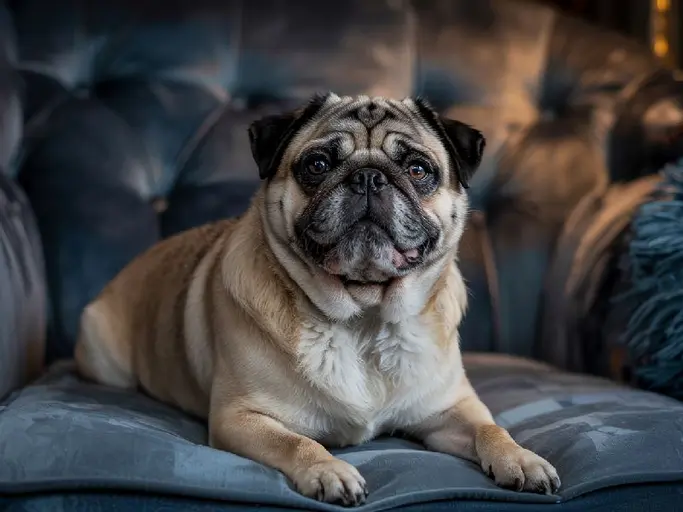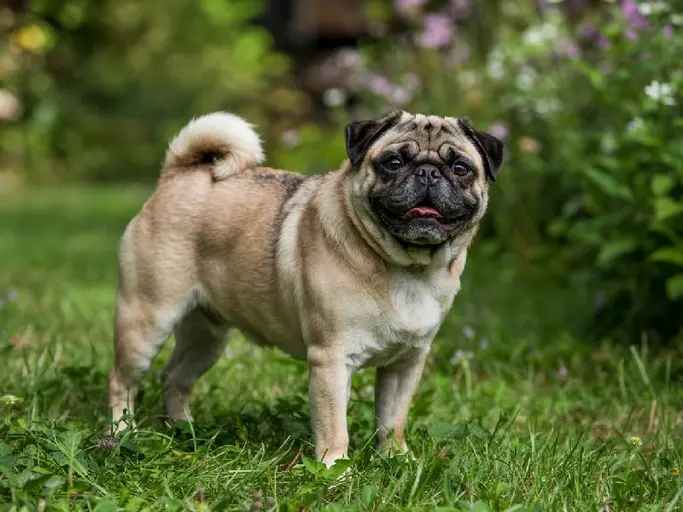The Charming Pug: A Comprehensive Breed Guide

Brief Introduction
The Pug, with its distinctive wrinkly face, short muzzle, and curled tail, is a breed that exudes charm and personality. Instantly recognizable, the Pug is a small dog with a big heart, known for its playful and affectionate nature. These little clowns are companion dogs through and through, thriving on human interaction and eager to be the center of attention. Their comical expressions and snorting sounds make them endlessly endearing, and their relatively small size makes them suitable for apartment living. However, potential owners should be aware of certain health concerns associated with the breed, particularly related to their brachycephalic (short-nosed) anatomy.
Breed History
The history of the Pug is rich and fascinating, tracing back centuries to ancient China.
Ancient Origins
The Pug is believed to have originated in China as early as the Han Dynasty (206 BC to 220 AD). They were highly prized by Chinese emperors and were kept as pampered companions in royal palaces. Pugs were considered luxury items and were even guarded by soldiers.
Spread to Europe
In the 16th century, Pugs made their way to Europe, likely carried by Dutch traders. The breed quickly gained popularity among European royalty. Legend has it that a Pug saved the life of William the Silent, Prince of Orange, by alerting him to the approach of Spanish troops in 1572. This event cemented the Pug’s place in Dutch history. Over time, Pugs became popular amongst royal families across Europe, including the British monarchy.
Breed Development
The Pug as we know it today was further developed in England during the 19th century. Three distinct lines of Pugs emerged, each traced back to imported dogs from China. These lines were instrumental in shaping the breed’s characteristics and solidifying its popularity as a beloved companion animal.
Appearance
The Pug’s unique appearance is one of its most defining features.
Height and Weight
Pugs typically stand between 10 and 14 inches tall (25-35 cm) and weigh between 14 and 18 pounds (6-8 kg). They are compactly built, with a square body and well-developed muscles.
Coat
The Pug has a short, glossy coat that comes in several colors, including fawn, black, silver fawn, and apricot fawn. Fawn is the most common color. The coat is relatively easy to care for, but Pugs do shed, especially during seasonal changes.
Ears
Pug ears come in two shapes: “rose” and “button.” Rose ears are small and folded back to reveal the inner ear, while button ears fold forward, covering the ear canal. Button ears are generally preferred in the show ring.
Eyes
Pugs have large, round, dark eyes that are prominent and expressive. Their eyes are one of their most endearing features, but they are also prone to certain health problems, such as proptosis (eye popping out of the socket) due to their shallow eye sockets.
Tail
The Pug’s tail is curled tightly over the back, ideally with a double curl. The curl is considered a desirable trait in the breed standard.
Wrinkles
The Pug’s wrinkled face is perhaps its most iconic feature. These wrinkles are not just for show; they require regular cleaning to prevent infections and skin irritation. Deep wrinkles can trap dirt and moisture, creating a breeding ground for bacteria.
Character and Behavior
Pugs are known for their charming and affectionate personalities.
Attitude Towards People
Pugs are incredibly people-oriented dogs. They thrive on human companionship and love nothing more than to be with their families. They are generally friendly and outgoing with strangers, making them poor guard dogs. They are happiest when they are by your side, whether you’re relaxing on the couch or going for a walk.
Attitude Towards Children
Pugs are generally good with children, especially if they are raised together. However, it’s important to teach children how to interact with Pugs respectfully, as they are small dogs and can be easily injured. Supervision is always recommended when Pugs are around young children.
Attitude Towards Animals
Pugs can get along well with other dogs and cats, especially if they are socialized from a young age. However, some Pugs may exhibit possessive behavior towards their toys or food, so it’s important to introduce them to other animals gradually and supervise their interactions.
Activity Level
Pugs have a moderate activity level. They enjoy short walks and playtime, but they are not high-energy dogs. Due to their brachycephalic anatomy, Pugs are prone to overheating and breathing difficulties, so it’s important to avoid strenuous exercise, especially in hot or humid weather.
Trainability
Pugs are intelligent dogs, but they can also be stubborn and easily distracted. Training requires patience, consistency, and positive reinforcement. Food rewards and praise are often effective motivators for Pugs. House training can sometimes be a challenge. Early socialization and obedience training are crucial for developing well-behaved Pugs.
Breed Characteristics
Pugs are known for their playful and comical personalities. They are often described as clowns, and they love to entertain their families with their silly antics. They are also known for their snoring and snorting sounds, which can be endearing to some owners but annoying to others. Pugs are sensitive dogs and can be easily upset by harsh treatment or loud noises.

Care and Maintenance
Caring for a Pug requires attention to their specific needs.
Care Features
Regular grooming is essential for maintaining a Pug’s health and appearance. This includes brushing their coat several times a week to remove loose hair and prevent matting. Cleaning their facial wrinkles daily is crucial to prevent infections. Nail trimming should be done regularly to prevent overgrowth and discomfort.
Exercise
Pugs need regular exercise, but it should be moderate and appropriate for their breed. Short walks and playtime in a cool environment are ideal. Avoid strenuous exercise, especially in hot or humid weather, as Pugs are prone to overheating.
Feeding
Pugs are prone to obesity, so it’s important to feed them a balanced diet and monitor their weight. Choose a high-quality dog food that is appropriate for their age and activity level. Avoid overfeeding and limit treats. Measure their food portions carefully and consult with a veterinarian about their dietary needs.
Grooming Needs
Pugs have a short, smooth coat that requires minimal grooming. They do shed, so regular brushing is important to remove loose hair. They do not require haircuts, but their wrinkles need daily cleaning.
Health
Pugs are prone to several health problems, including:
- Brachycephalic Obstructive Airway Syndrome (BOAS): This condition is caused by the Pug’s short nose and flattened face, which can lead to breathing difficulties.
- Eye problems: Pugs are prone to proptosis, corneal ulcers, and progressive retinal atrophy (PRA).
- Hip dysplasia: This is a condition in which the hip joint doesn’t develop properly, leading to pain and lameness.
- Patellar luxation: This is a condition in which the kneecap pops out of place.
- Skin problems: Pugs are prone to skin infections, allergies, and dermatitis.
- Pug Dog Encephalitis (PDE): A fatal inflammatory brain disease unique to Pugs.
Regular veterinary checkups are essential for monitoring a Pug’s health and addressing any potential problems early on.
Breed Weaknesses
While Pugs are generally affectionate and friendly, they do have some inherent weaknesses.
Level of Aggression
Pugs are not typically aggressive dogs. However, like all dogs, they can become aggressive if they feel threatened or provoked. Early socialization and training can help to prevent aggressive behavior.
Loyalty
Pugs are very loyal to their families and thrive on human companionship. They are not independent dogs and do best in homes where they receive plenty of attention.
Specific Weaknesses
- Prone to health problems due to their brachycephalic anatomy.
- Can be stubborn and difficult to train.
- Shed heavily.
- Prone to obesity.
- Sensitive to heat and humidity.
Conclusion
The Pug is a charming and affectionate breed that makes a wonderful companion for the right owner. They are best suited for people who can provide them with plenty of attention, love, and care. While they are not high-energy dogs, they do need regular exercise and mental stimulation. Pugs are also prone to certain health problems, so it’s important to be prepared for potential veterinary expenses. If you are looking for a loyal and entertaining companion with a big personality, the Pug may be the perfect breed for you. However, you need to be aware of the specific considerations and care requirements of this breed and be fully prepared to meet these needs.
Frequently Asked Questions About Pugs
-
What is a Pug’s personality like?
Pugs are known for their charming and affectionate personalities. They are playful, comical, and love to entertain their families. They thrive on human companionship and are happiest when they are by your side.
-
Are Pugs good with children?
Pugs are generally good with children, especially if they are raised together. However, it’s important to teach children how to interact with Pugs respectfully, as they are small dogs and can be easily injured. Supervision is always recommended when Pugs are around young children.
-
How much exercise does a Pug need?
Pugs have a moderate activity level. They enjoy short walks and playtime, but they are not high-energy dogs. Due to their brachycephalic anatomy, Pugs are prone to overheating and breathing difficulties, so it’s important to avoid strenuous exercise, especially in hot or humid weather.
-
Are Pugs easy to train?
Pugs are intelligent dogs, but they can also be stubborn and easily distracted. Training requires patience, consistency, and positive reinforcement. Food rewards and praise are often effective motivators for Pugs. Early socialization and obedience training are crucial for developing well-behaved Pugs.
-
What are some common health problems in Pugs?
Pugs are prone to several health problems, including Brachycephalic Obstructive Airway Syndrome (BOAS), eye problems (proptosis, corneal ulcers, progressive retinal atrophy), hip dysplasia, patellar luxation, skin problems, and Pug Dog Encephalitis (PDE).
-
How do I care for a Pug’s wrinkles?
Pug’s facial wrinkles require regular cleaning to prevent infections and skin irritation. Deep wrinkles can trap dirt and moisture, creating a breeding ground for bacteria. Clean their facial wrinkles daily.
-
Do Pugs shed a lot?
Yes, Pugs do shed, especially during seasonal changes. Regular brushing is important to remove loose hair.
-
What is the average weight and height of a Pug?
Pugs typically stand between 10 and 14 inches tall (25-35 cm) and weigh between 14 and 18 pounds (6-8 kg).
-
Are Pugs good with other animals?
Pugs can get along well with other dogs and cats, especially if they are socialized from a young age. However, some Pugs may exhibit possessive behavior towards their toys or food, so it’s important to introduce them to other animals gradually and supervise their interactions.
-
What colors do Pugs come in?
The Pug has a short, glossy coat that comes in several colors, including fawn, black, silver fawn, and apricot fawn. Fawn is the most common color.

